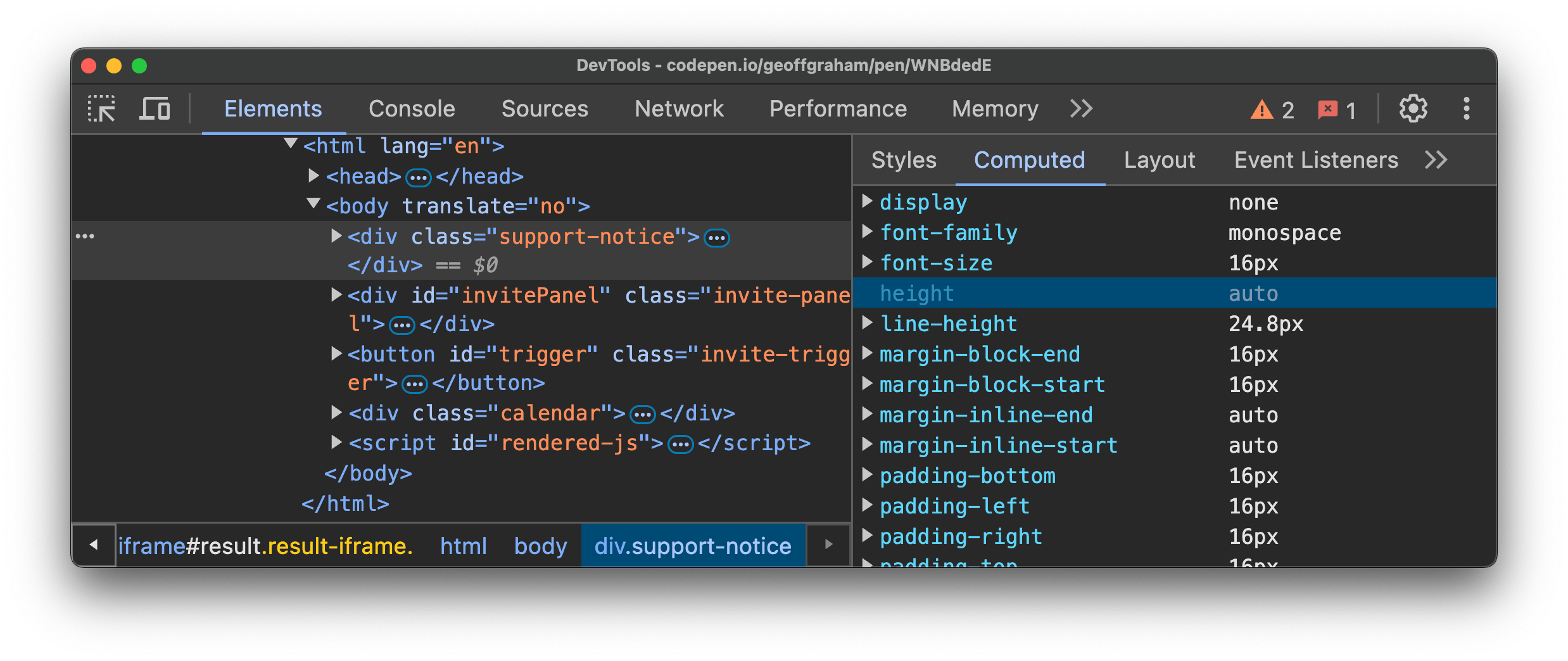This is one of the first questions that popped into my head when I read Chris’s post and he gets into that as well. Transitioning from an element from display: none to its intrinsic size is sort of like going from height: 0. It might seem like a non-displayed element has zero height, but it actually does have a computed height or auto unless a specific height is declared on it.
Here’s the situation. You have an element. You’ve marked it up, plopped in contents, and applied a bunch of styles to it. Do you know how tall it is? Of course not! Sure, we can ask JavaScript to evaluate the element for us, but as far as CSS is concerned, the element’s computed dimensions are unknown.
The problem
This is the relevant CSS:
That’s the goal, right? We tend to reach for height: auto when the height dimension is unknown. From there, we let JavaScript calculate what that evaluates to and take things from there.
The current Chrome implementation uses CSS calc() to do the heavy lifting. It recognizes the auto keyword and, true to its name, calculates that number. In other words, we can do this instead of the fixed-height approach:
A video in case you don’t feel like opening Canary:
Transitioning to auto
.element {
/* etc. */
@starting-style {
height: 0;
}
}
.element {
/* hard mode!! */
display: none;
transition: height 0.2s ease-in-out;
transition-behavior: allow-discrete;
height: 0;
@starting-style {
height: 0;
}
&.open {
height: calc(auto);
}
}
- The element starts with both
display: noneandheight: 0. - There’s an
.openclass that sets the element’s height tocalc(auto).
I had to give it a try. I’m sure there are a ton of use cases here, but I went with a floating button in a calendar component that indicates a certain number of pending calendar invites. Click the button, and a panel expands above the calendar and reveals the invites. Click it again and the panel goes back to where it came from. JavaScript is handling the click interaction, triggering a class change that transitions the height in CSS.
.invite-panel {
height: 0;
overflow-y: clip;
transition: height 0.25s ease-in;
}
I say this is about the height property, but we’re also talking about the logical equivalent, block-size, as well as width and inline-size. Or any direction for that matter!
.panel {
height: 0;
transition: height 0.25s ease-in;
&.expanded {
height: 300px;
}
}
That makes it difficult to, say, animate that element from height: 0 to height: whatever. We need to know what “whatever” is and we can only do that by setting a fixed height on the element. That way, we have numbers to transition from zero height to that specific height.
<div class="invite-panel" style="height: calc(auto)">
I know this is something Chris has wanted forever, so it’s no surprise he’s already got a fantastic write-up just a day after the news broke. In fact, I first learned about it from his post and was unable to dredge up any sort of announcement. So, I thought I’d jot some notes down because it feels like a significant development.

.panel {
height: 0;
transition: height 0.25s ease-in;
&.expanded {
height: calc(auto);
}
}
Direct Link →
So, there’s extra work to do if we want to transition from display: none in CSS. I’ll simply plop in the code Chris shared because it nicely demonstrates the key parts:
Well, DevTools showed us right there that height: auto is a discrete property! Notice the @starting-style declaration, though. If you’re unfamiliar with it, you’re not alone. The idea is that it lets us set a style for a transition to “start” with. And since our element’s discrete height is auto, we need to tell the transition to start at height: 0 instead:
The news: transitioning to auto is now a thing! Well, it’s going to be a thing. Chrome Canary recently shipped support for it and that’s the only place you’ll find it for now. And even then, we just don’t know if the Chrome Canary implementation will find its way to the syntax when the feature becomes official.






